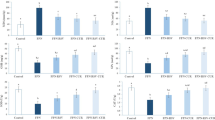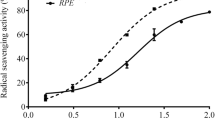Abstract
Cu is toxic to humans and other animals. Oxidative stress is an important mechanism involved in Cu toxicity. Resveratrol (RSV) is an antioxidative compound, so could counteract Cu toxicity. The aim of this study was to determine whether RSV protects the liver from the effects of CuSO4. Forty male Sprague-Dawley rats (5 weeks old, 110–120 g) were divided into four groups (n = 10 per group), a control group and groups treated with CuSO4 at a dose of 200 mg/kg body weight (BW), RSV at a dose of 15 mg/kg BW, and CuSO4 at a dose of 200 mg/kg BW and RSV at a dose of 15 mg/kg BW. The treatments were orally administered for 30 days. The livers were removed from the rats at the end of the study, and the cytochrome P450, cytochrome b5, Cu, Fe, Zn, glutathione peroxidase, superoxide dismutase, reactive oxygen species, aspartate aminotransferase, and alanine aminotransferase concentrations in the livers were determined. CuSO4 decreased the BW, liver weight, and cytochrome P450, cytochrome b5, Fe, Zn, glutathione peroxidase, and superoxide dismutase concentrations but increased the Cu, aspartate aminotransferase, alanine aminotransferase, and reactive oxygen species concentrations relative to the control group. RSV alleviated the toxic effects of CuSO4 on the liver, indicating that RSV attenuates CuSO4-induced liver injury by decreasing the liver transaminase concentration and oxidative stress, promoting antioxidative activity and cytochrome P450 enzymes, and maintaining balance in the trace element concentrations. The results indicate that RSV could be used to treat CuSO4 toxicity.




Similar content being viewed by others
References
Pourahmad J, O'Brien PJ (2000) Contrasting role of Na(+) ions in modulating Cu(+2) or Cd(+2) induced hepatocyte toxicity. Chem Biol Interact 126:159–169
Gaetke LM, Chow CK (2003) Copper toxicity, oxidative stress, and antioxidant nutrients. Toxicology 189:147–163
Guicciardi ME, Malhi H, Mott JL, Gores GJ (2013) Apoptosis and necrosis in the liver. Compr Physiol 3. doi https://doi.org/10.1002/cphy.c120020
Du X, Zhu Y, Peng Z, Cui Y, Zhang Q, Shi Z, Guan Y, Sha X, Shen T, Yang Y et al (2018) High concentrations of fatty acids and beta-hydroxybutyrate impair the growth hormone-mediated hepatic JAK2-STAT5 pathway in clinically ketotic cows. J Dairy Sci 101:3476–3487
Bogdanos DP, Gao B, Gershwin ME (2013) Liver immunology. Compr Physiol 3:567–598
Fry RS, Ashwell MS, Lloyd KE, O'Nan AT, Flowers WL, Stewart KR, Spears JW (2012) Amount and source of dietary copper affects small intestine morphology, duodenal lipid peroxidation, hepatic oxidative stress,and mRNA expression of hepatic copper regulatory proteins in weanling pigs. J Anim Sci 90:3112–3119
Allen KJ, Buck NE, Cheah DM, Gazeas S, Bhathal P, Mercer JF (2006) Chronological changes in tissue copper, zinc and iron in the toxic milk mouse and effects of copper loading. Biometals 19:555–564
Figueiredo-Fernandes A, Ferreira-Cardoso JV, Garcia-Santos S, Monteiro SM, Carrola J, Matos P, Fontaínhas-Fernandes A (2007) Histopathological changes in liver and gill epithelium of Nile tilapia, Oreochromis niloticus, exposed to waterborne copper. Pesqui Vet Bras 27:103–109
Song Y, Li N, Gu J, Fu S, Peng Z, Zhao C, Zhang Y, Li X, Wang Z, Li X, Liu G (2016) Beta-hydroxybutyrate induces bovine hepatocyte apoptosis via an ROS-p38 signaling pathway. J Dairy Sci 99:9184–9198
Husak VV, Mosiichuk NM, Kubrak OI, Matviishyn TM, Storey JM, Storey KB, Lushchak VI (2018) Acute exposure to copper induces variable intensity of oxidative stress in goldfish tissues. Fish Physiol Biochem 44:841–852
Akbary P, Sartipi Yarahmadi S, Jahanbakhshi A (2018) Hematological, hepatic enzymes' activity and oxidative stress responses of gray mullet (Mugil cephalus) after sub-acute exposure to copper oxide. Environ Sci Pollut Res Int 25:1800–1808
Jagdeo J, Adams L, Lev-Tov H, Sieminska J, Michl J, Brody N (2010) Dose-dependent antioxidant function of resveratrol demonstrated via modulation of reactive oxygen species in normal human skin fibroblasts in vitro. J Drugs Dermatol 9:1523–1526
de la Lastra CA, Villegas I (2007) Resveratrol as an antioxidant and pro-oxidant agent: mechanisms and clinical implications. Biochem Soc Trans 35:1156–1160
Marques FZ, Markus MA, Morris BJ (2009) Resveratrol: cellular actions of a potent natural chemical that confers a diversity of health benefits. Int J Biochem Cell Biol 41:2125–2128
Palsamy P, Subramanian S (2011) Resveratrol protects diabetic kidney by attenuating hyperglycemia-mediated oxidative stress and renal inflammatory cytokines via Nrf2-Keap1 signaling. Biochim Biophys Acta 1812:719–731
Sadi G, Konat D (2016) Resveratrol regulates oxidative biomarkers and antioxidant enzymes in the brain of streptozotocin-induced diabetic rats. Pharm Biol 54:1156–1163
Asadi S, Moradi MN, Khyripour N, Goodarzi MT, Mahmoodi M (2017) Resveratrol attenuates copper and zinc homeostasis and ameliorates oxidative stress in type 2 diabetic rats. Biol Trace Elem Res 177:132–138
Matos L, Gouveia AM (2017) Resveratrol attenuates copper-induced senescence by improving cellular proteostasis. 2017:3793817
San Miguel SM, Opperman LA, Allen EP, Zielinski JE, Svoboda KK (2013) Antioxidant combinations protect oral fibroblasts against metal-induced toxicity. Arch Oral Biol 58:299–310
Liu JY, Yang X, Sun XD, Zhuang CC, Xu FB, Li YF (2016) Suppressive effects of copper sulfate accumulation on the spermatogenesis of rats. Biol Trace Elem Res 174:356–361
Khushboo M, Murthy MK, Devi MS, Sanjeev S, Ibrahim KS, Kumar NS, Roy VK, Gurusubramanian G (2018) Testicular toxicity and sperm quality following copper exposure in Wistar albino rats: ameliorative potentials of L-carnitine. Environ Sci Pollut Res Int 25:1837–1862
Musacco-Sebio R, Saporito-Magrina C, Semprine J, Torti H, Ferrarotti N, Castro-Parodi M, Damiano A, Boveris A, Repetto MG (2014) Rat liver antioxidant response to iron and copper overloads. J Inorg Biochem 137:94–100
Zakaria MMH, Hajipour B, Estakhri R, Saleh BM (2017) Anti-oxidative effect of resveratrol on aluminum induced toxicity in rat cerebral tissue. Bratisl Lek Listy 118:269–272
Banu SK, Stanley JA, Sivakumar KK, Arosh JA, Burghardt RC (2016) Resveratrol protects the ovary against chromium-toxicity by enhancing endogenous antioxidant enzymes and inhibiting metabolic clearance of estradiol. Toxicol Appl Pharmacol 303:65–78
Li X, Huang W, Gu J, Du X, Lei L, Yuan X, Sun G, Wang Z, Li X, Liu G (2015) SREBP-1c overactivates ROS-mediated hepatic NF-kappaB inflammatory pathway in dairy cows with fatty liver. Cell Signal 27:2099–2109
Zhu Y, Han Y, Zhao H, Li J, Hu C, Li Y, Zhang Z (2013) Suppressive effect of accumulated aluminum trichloride on the hepatic microsomal cytochrome P450 enzyme system in rats. Food Chem Toxicol 51:210–214
Zhu Y, Li X, Chen C, Wang F, Li J, Hu C, Li Y, Miao L (2012) Effects of aluminum trichloride on the trace elements and cytokines in the spleen of rats. Food Chem Toxicol 50:2911–2915
Du X, Shi Z, Peng Z, Zhao C, Zhang Y, Wang Z, Li X, Liu G, Li X (2017) Acetoacetate induces hepatocytes apoptosis by the ROS-mediated MAPKs pathway in ketotic cows. J Cell Physiol 232:3296–3308
Sadi G, Baloğlu MC, Pektaş MB (2015) Differential gene expression in liver tissues of streptozotocin-induced diabetic rats in response to resveratrol treatment. PLoS One 10:e0124968
Hannemann F, Bichet A, Ewen KM, Bernhardt R (2007) Cytochrome P450 systems—biological variations of electron transport chains. Biochim Biophys Acta 1770:330–344
Rifkind AB (2006) CYP1A in TCDD toxicity and in physiology-with particular reference to CYP dependent arachidonic acid metabolism and other endogenous substrates. Drug Metab Rev 38:291–335
Chen X, Hall H, Simpson JP, Leon-Salas WD, Ready DF, Weake VM (2017) Cytochrome b5 protects photoreceptors from light stress-induced lipid peroxidation and retinal degeneration. NPJ Aging Mech Dis 3:18
Hsu M-H, Savas Ü, Lasker JM, Johnson EF (2011) Genistein, resveratrol, and 5-aminoimidazole-4-carboxamide-1-β-d-ribofuranoside induce cytochrome P450 4F2 expression through an AMP-activated protein kinase-dependent pathway. J Pharmacol Exp Ther 337:125–136
Peng HM, Auchus RJ (2013) The action of cytochrome b(5) on CYP2E1 and CYP2C19 activities requires anionic residues D58 and D65. Biochemistry 52:210–220
Zhao X, Wang J, Hu S, Wang R, Mao Y, Xie J (2017) Neuroprotective effect of resveratrol on rotenone-treated C57BL/6 mice. Neuroreport 28:498–505
Pratt DS, Kaplan MM (2000) Evaluation of abnormal liver-enzyme results in asymptomatic patients. N Engl J Med 342:1266–1271
van Beek JH, de Moor MH, de Geus EJ, Lubke GH, Vink JM, Willemsen G, Boomsma DI (2013) The genetic architecture of liver enzyme levels: GGT, ALT and AST. Behav Genet 43:329–339
Mari M, Caballero F, Colell A, Morales A, Caballeria J, Fernandez A, Enrich C, Fernandez-Checa JC, Garcia-Ruiz C (2006) Mitochondrial free cholesterol loading sensitizes to TNF- and Fas-mediated steatohepatitis. Cell Metab 4:185–198
El-Boghdady NA, Abdeltawab NF, Nooh MM (2017) Resveratrol and montelukast alleviate paraquat-induced hepatic injury in mice: modulation of oxidative stress, inflammation, and apoptosis. Oxid Med Cell Longev 2017:9396425
Peiyuan H, Zhiping H, Chengjun S, Chunqing W, Bingqing L, Imam MU (2017) Resveratrol ameliorates experimental alcoholic liver disease by modulating oxidative stress. Evid Based Complement Alternat Med 2017:4287890
Anderson ER, Shah YM (2013) Iron homeostasis in the liver. Compr Physiol 3:315–330
Tian X, Zheng Y, Li Y, Shen Z, Tao L, Dou X, Qian J, Shen H (2014) Psychological stress induced zinc accumulation and up-regulation of ZIP14 and metallothionein in rat liver. BMC Gastroenterol 14:32
Zhong W, Zhao Y, Sun X, Song Z, McClain CJ, Zhou Z (2013) Dietary zinc deficiency exaggerates ethanol-induced liver injury in mice: involvement of intrahepatic and extrahepatic factors. PLoS One 8:e76522
Fridovich I (1995) Superoxide radical and superoxide dismutases. Annu Rev Biochem 64:97–112
Semprine J, Ferrarotti N, Musacco-Sebio R, Saporito-Magrina C, Fuda J, Torti H, Castro-Parodi M, Damiano A, Boveris A, Repetto MG (2014) Brain antioxidant responses to acute iron and copper intoxications in rats. Metallomics 6:2083–2089
Rodriguez-Bies E, Tung BT, Navas P (2016) Resveratrol primes the effects of physical activity in old mice. 116:979–988
Acknowledgments
Thanks for all the authors’ contribution to this manuscript.
Author information
Authors and Affiliations
Corresponding author
Ethics declarations
The experimental protocol was approved by the Ethics Committee for the Use and Care of Animals, China–Japan Union Hospital, Jilin University, China.
Conflict of Interest
The authors declare that they have no conflict of interest.
Rights and permissions
About this article
Cite this article
Tian, Y., Wu, B., Li, X. et al. The Resveratrol Alleviates the Hepatic Toxicity of CuSO4 in the Rat. Biol Trace Elem Res 187, 464–471 (2019). https://doi.org/10.1007/s12011-018-1398-7
Received:
Accepted:
Published:
Issue Date:
DOI: https://doi.org/10.1007/s12011-018-1398-7




